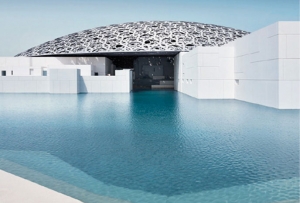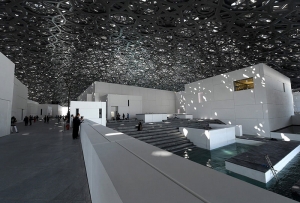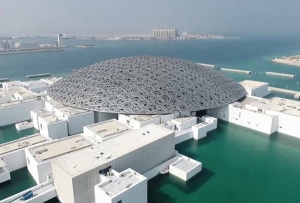The Louvre Abu Dhabi stands as a monument to tolerance and is intended to preserve and exhibit works of art from all periods, all cultural backgrounds and all geographical origins.
The exhibits include a 6th Century Koran, a Gothic Bible and a Torah from Yemen, and under the terms of the partnership agreement with the Louvre in Paris, France has loaned various masterpieces, including “Portrait of an Unknown Woman”, also known as “La Belle Ferronnière”, by Leonardo Da Vinci.
According to Jack Lang, Director of the Arab World Institute in Paris, the museum aspires to be “more universal than the Louvre in Paris, because it incorporates the idea of a museum of different continents and different civilizations. It is a project of hope for the advent of a world that respects the opinions of others and respects cultural and religious differences.”
The Louvre Abu Dhabi complex has 97,000 square meter of overall floor-space and consists of 55 buildings of different sizes and heights, which host exhibition galleries and assembly rooms.
Some of these spaces are also equipped with ornamental pools, finished with materials ranging from bronze to marble, and with lights and furnishings also designed by Nouvel. The complex includes areas that house the permanent collection, areas for temporary exhibitions, a children’s museum, an auditorium, bar, cafeteria, administrative offices and storage rooms for the artworks.
The most spectacular part of the complex is the perforated dome, which covers it completely and is reminiscent of the intricate curtain wall that Nouvel designed for the exterior of Arab World Institute in Paris. Engineered and calculated by Buro Happold, the dome has a diameter of 180 metres and consists of a double, completely perforated aluminium roof that has the appearance of being suspended at a height of 30 metres. The two distinct shells contain a dense latticework created by joining eight distinct designs, four for each roof, which form 7,850 stars of different sizes. The interweaving of these creates a tight mesh that nonetheless lets beams of light filter through to the interior, like a “shower of light”, according to the architect.
Like in the medina quarters of North African cities, this roof provides shade for the passage ways below, shelters them from direct sunlight and helps reduce the temperature.
The role of FILA
As a museum-city built on the sea, the Louvre Abu Dhabi needs the best protection for its coverings, so FILA Surface Care Solutions was assigned the task of protecting the pools and the outdoor paving in grey limestone with HYDROREP solvent-based water-repellent protector, FILAPW10 pre-fixing efflorescence-blocking protector and FILAMP90 Eco Plus water-based stain-proofing protector.
“The task assigned to us at the Louvre Abu Dhabi was very challenging in terms of technical requirements,” explained Fabrizio Nicoli, Sales Director of Fila Middle East. “The brief was to retain the natural appearance of the coverings and provide perfect waterproof protection in an environment that is particularly complicated, because the pools have sea water flowing through them, which has high sodium content, and the climate is very hot and humid. After conducting a series of tests, the contracting authority selected our products because of their high performance and effectiveness in these conditions.”
FILA had already taken part in another, equally critical, demanding and prestigious project in the United Arab Emirates, at the new Presidential Palace in Abu Dhabi, where the company was commissioned to take care of the protective treatment of the indoor and outdoor coverings.
FILAPW10 pre-fixing protector and HYDROREP water-repellent protector are two of the leading waterproofing solutions that Fila offers in the Middle East, which is a strategic market for the company. In 2013 it opened a sixth branch there, to help consolidate the brand’s presence in the region and facilitate its expansion into South Pacific Asia.
Reference: TILE INTERNATIONAL 1 /2020, page 110
Translated by Maryam Hosseini in Ceramic World Review Persian, no.42 , pages 64/ June 2020
CLICK HERE
The Louvre Abu Dhabi, designed by the French starchitect Jean Nouvel, incorporates products by FILA Surface Care Solutions. The building, which forms part of an agreement signed in 2006 by Abu Dhabi and the French government, stands on the shore of the artificial island of Saadiyat and is the largest museum on the Arabian peninsula.
Jean Nouvel was born in Fumel (France) in 1945. After graduating from the École Nationale Supérieure des Beaux-Arts in Paris in 1972, he worked as an assistant to Claude Parent and the urbanist Paul Virilio, before opening his first firm in 1970. He co-founded the movement Mars 1976 and the Syndicat de l’Architecture the following year to counter the impact of corporatism, and in 1980 he founded the Biennale de l’Architecture within the framework of the Biennale de Paris.
The distinctive character of his work helped forge his international reputation. His key works include the Arab World Institute, the Cartier Foundation for Contemporary Art and the Quai Branly Museum – Jacques Chirac in Paris, the KKL Cultural and Congress Centre in Lucerne (Switzerland), the Torre Agbar in Barcelona (Spain), the Reina Sofia National Art Museum in Madrid (Spain), 40 Mercer in New York (USA), One Central Park in Sydney (Australia), the White Walls Tower in Nicosia (Cyprus), the Guthrie Theater in Minneapolis (USA) and the Danish Radio concert hall in Copenhagen (Denmark).
He has won numerous prizes and awards, including: the Aga Khan Prize for Architecture for the Arab World Institute in 1989; a Golden Lion at the 7th International Architecture Exhibition – Venice Biennale in 2000; a Royal Gold Medal from the Royal Institute of British Architects (RIBA), the Praemium Imperiale for Architecture from the Japan Art Association and the International Francesco Borromini Prize run by the City of Rome for the KKL Cultural Centre in Lucerne, all in 2001. He was awarded the Pritzker Prize in 2008.



















Leave A Comment